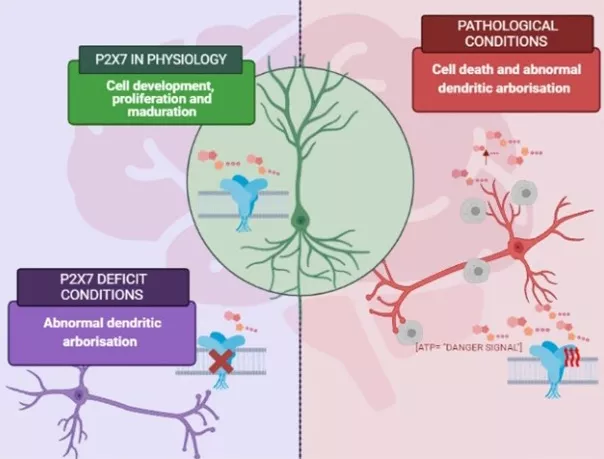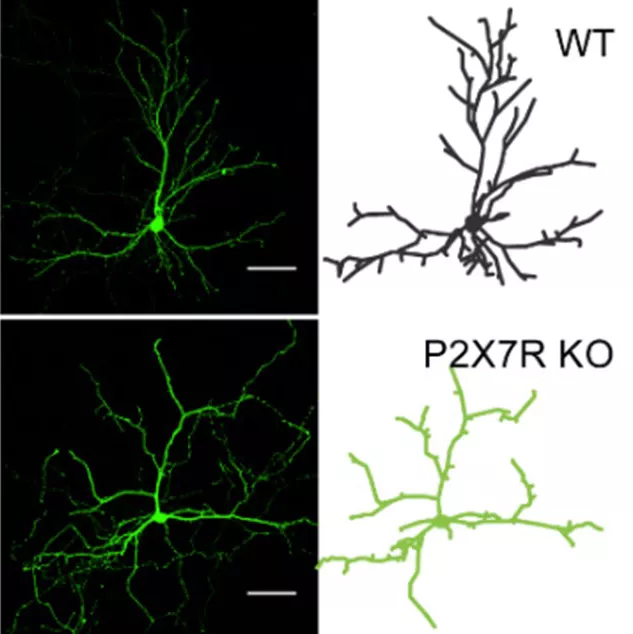Dual role of the P2X7 receptor revealed in the hippocampus during physiological and pathological brain development
In a landmark study, researchers from the Laboratory of Molecular Pharmacology at the ELKH Institute of Experimental Medicine (IEM), led by Beata Sperlágh, in collaboration with the Universidad Autonóma de Madrid, have shown a direct link between the P2X7 purinergic receptor and the growth and sprouting of pyramidal neurons in the hippocampus – the brain region best known for its memory-related processes. The discovery could be crucial to understanding the mechanisms of brain formation that often underlie the critical period of normal brain development. The study was published in the prestigious Nature Index periodical, The Journal of Neuroscience.
Pyramidal cells, or pyramidal neurons, are found in numerous areas of the brain and undergo many rapid changes during early postnatal life. Purinergic signaling is a form of signaling mediated by purines, including ATP and its breakdown products, which activate purinergic receptors in cells, thereby regulating cellular functions.
Inflammatory processes also play a crucial role in altered brain function and in the development of neurological diseases and disorders such as stroke, Alzheimer's disease, Parkinson's disease, epilepsy, dementia, and neurodevelopmental disorders. Neurodevelopmental disorders such as autism and schizophrenia are thought to be the result of abnormal inflammatory events at critical points in brain development. The goal of the research was to establish whether the P2X7 receptor could act as a therapeutic target in these disorders to reduce the susceptibility of adolescents and young individuals to develop these symptoms.
The published study demonstrates the regulatory effects of P2X7R on neuronal outgrowth and morphology in primary cultures of mouse hippocampal neurons and acute hippocampal slices. The researchers also examined dendritic morphology in a mouse model of schizophrenia and investigated the relationship between abnormal dendritogenesis and human pathologies. They aimed to determine whether P2X7R, a leading player in inflammatory events in the brain under pathological conditions, plays a regulatory role in the complex pathomechanism of psychiatric disorders.

1. ábra: A P2X7 receptor és szerepei (Biorender-ábra)
Beáta Sperlágh's laboratories have pioneered the description of the role of purinergic signaling in the central nervous system, and over the past twenty years, they have identified new purinergic drug targets for diseases such as depression, schizophrenia, and neurodevelopmental disorders.
In their newly published study, they have identified a novel role for P2X7 in the small window of time during early pregnancy that is required for proper pyramidal cell development. Genetically engineered mice without the P2X7 receptor showed poorer performance in memory tests at a young age. Likewise, abnormal activation of the P2X7 receptor, which may be a consequence of inflammatory processes during pregnancy, resulted in a detrimental effect on neuronal development.
In a mice model of schizophrenia, a susceptibility in the adult to worsening their performance in several tests was also observed, similar to the deficits observed in human patients. Altogether, this shows a particular role of the receptor that needs to be strictly balanced during the gestational process to develop a healthy brain.

Figure 2. Confocal laser scanning microscopic image of a representative primary hippocampal neurons from a control wild-type embryos (WT) and P2X7-deficient neurons (P2X7 KO). The pictures demonstrate the difference when the receptor was not present in the process of development. Scale bar is 200 µm.
The first author Paula Mut Arbona used primary hippocampal cultures combined with immunostaining, confocal microscopy, and ex vivo studies during their investigations, while Professor Antonio García’s laboratory in Spain was involved in the synthesis of a new P2X7 ligand antagonizing the receptor. Using a multifaceted approach, the researchers proved the importance of the activity of the receptor in both physiology and pathology using in vivo behavioral experiments and disease models in mice.
The significance of this discovery can be illustrated by the fact that either blockade of the receptor or pathological inhibition of the receptors prevents the development of the typical cortical structure. Hence, purinergic signaling should be considered an essential therapeutic target for neurodevelopmental disorders and other conditions.
Publication:
Paula Mut-Arbona, Lumei Huang, Mária Baranyi, Pál Tod, András Iring, Francesco Calzaferri, Cristobal de los Ríos and Beáta Sperlágh (2023). Dual role of the P2X7 receptor in dendritic outgrowth during physiological and pathological brain development. Journal of Neuroscience. Doi: 10.1523/JNEUROSCI.0805-22.2022

